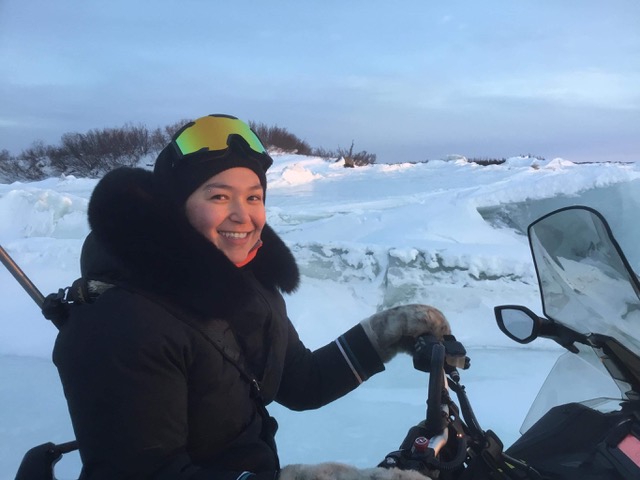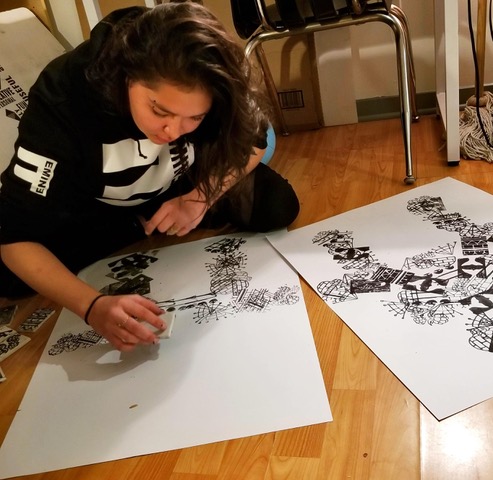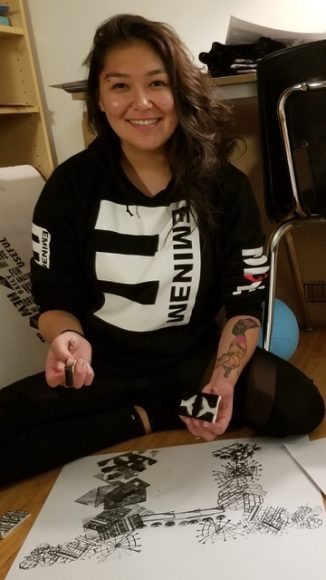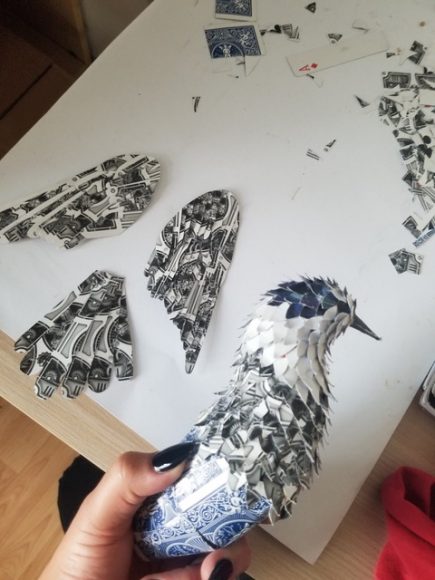CMS: Can you tell us a little about your home community?
AC: Nunavik is very different from the South. It is very isolated. There are no trains, no roads to get there. You can only go by plane. Approximately 2,700 people live in Kuujjuaq, my home community. Everyone knows everyone – and nothing is far away. We don’t have as many restaurants or stores as the South, but there are some. There are a couple of hotels and bars, three general stores, a craft shop, an arena/gym, three churches and a bank. There are no sidewalks. There are a lot of stray dogs, and kids play outside without any adults around. We have [coniferous] trees where I live and there are two beaches. Around us, there are many lakes and all different types of animals – black bears, squirrels, rabbits, wolves, fox, and apparently, lynx. Kuujjuaq is pretty “civilized” and the caribou [tuttuit] know to stay away from town because we are always hunting for them.
CMS: What is your connection to the land?
AC: I grew up going camping and hunting with my parents either by boat or Ski-doo. I mostly hunted for ptarmigan [aqiggik] and geese [nirliit].
CMS: The first kill is an important milestone in the life of an Inuk. Do you remember your first kill?
AC: Actually, no, I was really young, around six years old.
CMS: Has anyone told you what happened that day?
AC: My father told me it was wintertime. We were on the Ski-doo hunting. We saw ptarmigan so we went close and he gave me his .22 rifle. He told me to shoot straight at them and when I started, they flew away. They were right in front of us and I was shaking so much I almost shot my dad’s Ski-doo windshield. But I don’t recall anything.
CMS: Did you actually kill one?
AC: I’m not sure. I think I got one before accidentally almost shooting the windshield.
CMS: Do you think that the Inuit view nature differently from people down here?
AC: I feel like people in the South experience camping in different ways than we do. We are more experienced in that we have always lived that type of lifestyle – going out on the land, going hunting. Our Elders taught us to respect our land.
Whenever we go hunting, we take every part of the animal except the guts and bones. We never let anything go to waste. That’s what we respect, that’s how we were taught to hunt. I don’t know, I feel like other people don’t respect the whole animal. They only take the part they want and leave the rest of the carcass, when they could’ve used it all for something.
CMS: For one of your classes, you were asked to sculpt a bird out of playing cards and glue only. You chose the Whiskey Jack. What is it called in Inuktitut and why did you choose it?
AC: The Whiskey Jack is called qupanuarjuaq. When my parents and I used to go camping at our cabin, we would wake up and cook breakfast on the woodstove, and each time we had leftovers we would feed the Whiskey Jacks. They would come to our window where the leftovers were, and we would watch them eat. Sometimes I would put my hand out the window and they would land on it and grab the food and fly away. I was young and I found it very interesting to watch them.
CMS: Is the Whiskey Jack native to the area around Kuujuaq?
AC: I’ve heard that they’re all over Nunavik – I’m not sure if they’re all over Canada too – but I used to see them regularly in my home community, even in town.
CMS: I’ve never seen a Whiskey Jack, but your sculpture is incredibly lifelike. Would you say that part of the reason you were able to accurately reproduce this bird is because of your close observations of them as a child?
AC: I would say, yes. I feel like because of my experiences, it was the perfect choice for this assignment.
CMS: Did you use a book to help you or did you do it completely from memory?
AC: I looked at a few photos online to help me recall some specific details like their wings and colour and size, stuff like that.
CMS: You seem to have chosen a very time-consuming method to accurately recreate each element of the Whiskey Jack, almost to the point of making each individual feather. You even emailed your teacher to say that your assignment would be a little late, not because you began the project late but because you wanted it to be perfect. Can you describe the process you went through to realistically represent this bird?
AC: Starting it was really hard. I was not given any instruction, so I had to figure it out myself. I started off by creating a base just with cards and then I began on the head. I kept adding more cards until it physically looked like a body. Then I cut up small card pieces to make feathers. I used different colours for the different parts of the body. The main colour of the Whiskey Jack is grey, so I put grey cards for the grey parts of the bird. I had long fake nails the whole time I was working on this project, so it was really difficult to do (laughs).
CMS: I’m guessing you chose playing cards with a particular print on the back?
AC: Mostly I was going for the colours I needed.
CMS: The bird is a little bigger than a human hand. How many decks did you use?
AC: The whole bird took me maybe three decks, with three different colours.
CMS: Where do you think your talent for art comes from?
AC: From my mother, especially, because she is also an artist. She sculpts, she makes jewelry out of ivory. She’s a really good painter, too, and she draws well. I think I grew into being an artist like she did. I also had a non-Indigenous teacher up north who was really good, and I think she inspired me as well.
CMS: Will Inuit cultural values and attitudes toward nature be themes in your future artwork?
AC: Yes, that’s currently what I’m doing now in some of my art classes. In printmaking I’ve been creating images of traditional things such as aqpiit [cloudberries]. I’ve been drawing igloos, uluit [the woman’s traditional knife], and tupiit [tents]. Also seals and whales.
CMS: So you’re really accessing your culture for your new material?
AC: Yes, I am. It seems that my fellow Inuit classmates are doing the same thing and that is motivating me, too.
CMS: You have told me that you were good at art when you were a child. What were you drawing in those days?
AC: I was mostly drawing animals, especially wolves because I like wolves. Dogs and wolves. I drew what was around me.
CMS: What are some of the challenges of studying visual arts in the South, where college is impersonal and more aligned with a western model of learning?
AC: Being homesick. For the land, for the people, for my food. I’m always craving country food [traditional foods such as caribou, seal, Arctic char, whale blubber, geese, bannock]. It is such a blessing whenever someone sends me some. It reminds me of being on the land and being in my hometown with family and friends— I’m almost crying now.
CMS: So, is it really worth it to be here when you’re missing out on all that?
AC: I think it’s worth it because I’m getting an education. It is difficult, but I need this because it will lead me to where I want to be in the future.
CMS: And what does that look like?
AC: Lately I’ve been thinking about becoming a tattoo artist.
CMS: Are you referring to the traditional Inuit tattoos?
AC: Yes, that’s what I’ve been thinking about. There are different meanings behind the tattoos. It depends on where they go on the body. They can go on your face, on your fingers, on your arms, on your wrists, on your upper chest, on your thighs. Each has a different significance.
CMS: My friend, Nancy Etok, in Kangiqsualujjuaq, explained to me that the ones on the fingers represent Sedna [The Sea Goddess in Inuit mythology] as a way to honour her fingers that were cut off. And the V-tattoo on the face is so that Sedna will recognize you in the afterlife. Is it true the traditional tattoos are mainly for women?
AC: No, men get them too.
CMS: Do you think it would be possible for you to earn a living this way?
AC: For me, it would be more like a side job. I would find something else for my main source of income.
CMS: Well, it seems your Whiskey Jack sculpture has generated some interest and might lead to an important sale. That must give you some kind of confidence.
AC: Yeah, it does. I’m excited that people are adoring it.
CMS: Making a sale is something that most artists dream of. It’s a great career boost. How do you think you will feel after you sell your Whiskey Jack?
AC: Sad, but also happy that others will get a chance to be amazed by it (laughs).














Well done Alice! I thoroughly enjoyed reading this interview!!